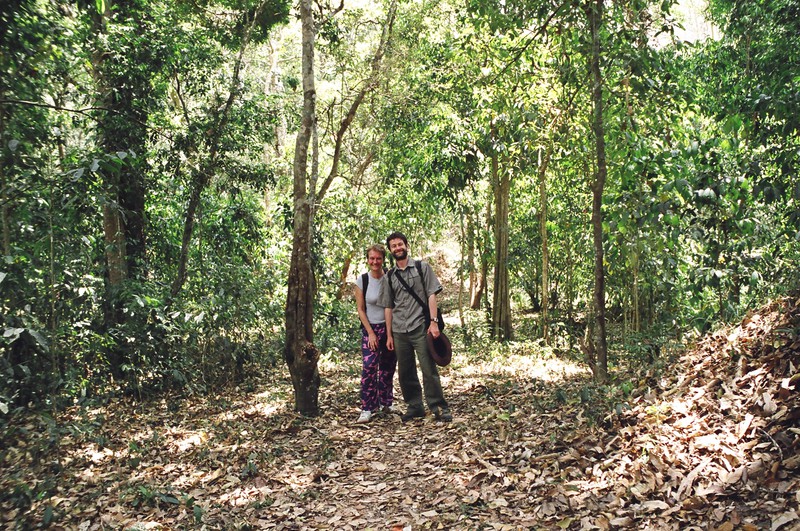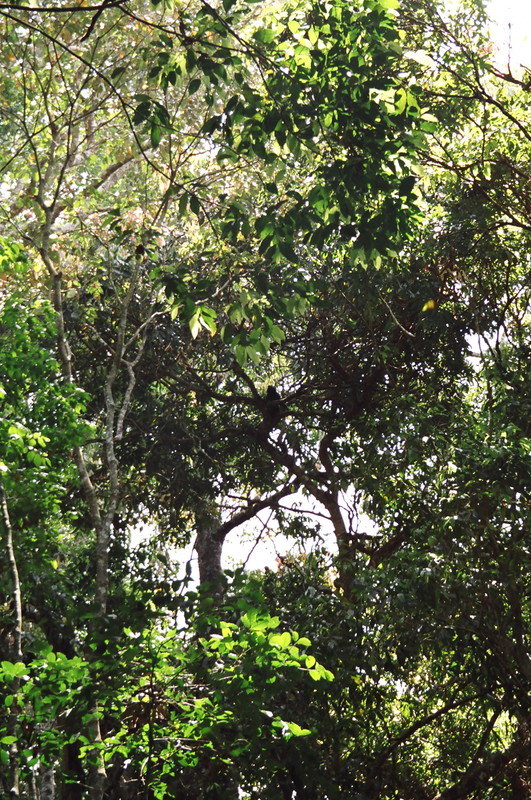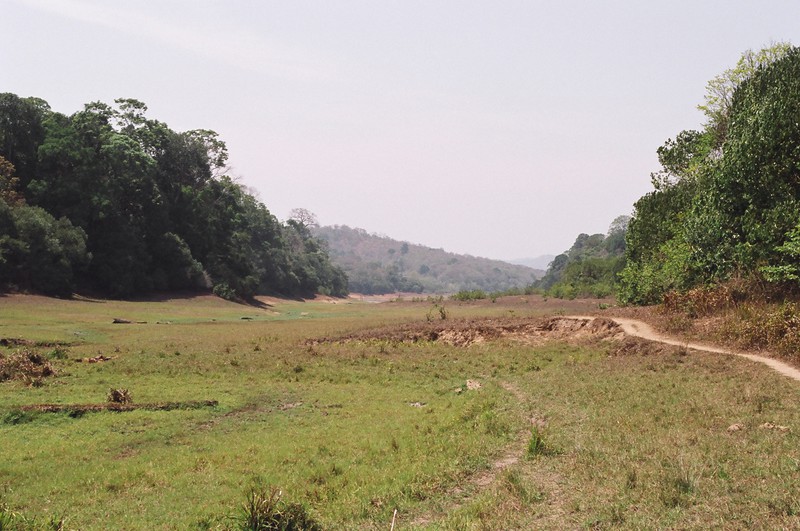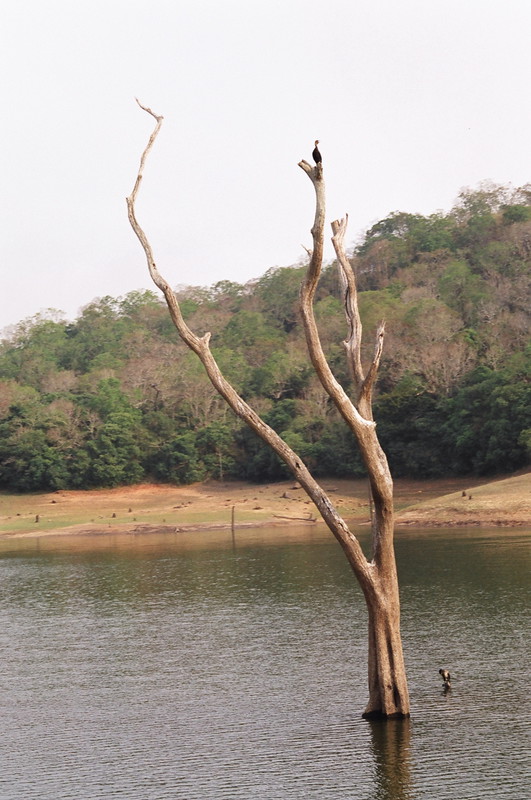
Periyar Wildlife Sanctuary is a funny old place. Yes, it might be one of the few places on earth where you can theoretically see tigers – though with only about 35 tigers in a 777km2 park, your chances are slimmer than slim – but it's also faintly depressing, particularly at the moment, because the veneer of tourism is so thick you have to dig quite deep to get away from it all. Luckily, when you do, Periyar is a delight.
First impressions are pretty awful, because most of the accommodation and restaurant action happens in the nearby village of Kumily, which is a forgettable slew of Kashmiri trinket shops, expensive resort hotels and unloved traveller hotels. The atmosphere, while still reasonably friendly and easy-going, is a world away from somewhere like Munnar, which is clearly a working town that happens to be popular with tourists; Kumily exists purely to service the nearby wildlife sanctuary and the tourists that flock here, and it feels like it. Walking the streets is an exercise in being as polite as possible to the incessant chants of, 'Hello, where you from, come into my shop, just looking, good price, you come back later maybe, yes see you, thank you,' all choreographed to head wobbling and 'No thanks' from the passing tourists. At this time of year, as the shoulder season slides into the off-season, the hassle is fairly mild and the shopkeepers are happy to take 'no' for an answer, but after an entire street has tried to entice you into their shop to check out their Kashmiri emporium of amazing pashminas and multi-armed statues of the Hindu pantheon, it makes you wonder what it's like in the high season, when tourists pile into the park in their air-conditioned coaches.

After a long, four-and-a-half hour journey from Munnar, we were fairly exhausted from bumping around in the back of the Ambassador, so we headed for the Coffee Inn, which the Lonely Planet gives a gushing review, managing to squeeze the words 'lovely', 'friendly', 'comfortable', 'laid-back', 'peaceful', 'great' and 'delicious' into just one paragraph of description. Unfortunately the Coffee Inn turned out to be a faded, faintly tacky place with a building site above it, where the owner has obviously decided to build the Coffee Inn Hotel, thus missing the point of the original inn's appeal by a country mile. Having met the owner, this doesn't surprise me, as he was a pretty grumpy bugger when we arrived, showing us to a hut down the road with all the shoe-dragging enthusiasm of a bored nine-year-old. Tired, we checked in anyway, happy just to have somewhere to dump our bags.

Kumily has a lot more to offer than backpacker haunts that have lost their sparkle, though. As we had an afternoon to kill, we thought we'd wander round the posh hotels in town to see if any of them were worth eating in (we'd grabbed a snack in the Coffee Inn, and it had turned out to have mediocre food and incredibly slow service, the latter not remotely mitigated by the sign saying, 'Please do not shout at the chef; good food takes time to make,' particularly as there was only a handful of other people in the place when we ate). We started with the Spice Village, which feels for all the world like a package holiday venue, with an uninspiring buffet restaurant, polite but slightly bewildered staff, an air of concrete hidden beneath the palm-tree exterior, and an astonishing price tag of US$210 per night for a double room (at least the Coffee Inn is honestly priced, at Rs400 for a double, or around US$9 per night). Our next stop was the Taj Garden, a really lovely wooden hotel set in delightful gardens, with a price tag of US$169 a night for a room and a restaurant that looks utterly wonderful; and our final visit was to the Tree Top Hotel, which has pleasant doubles at Rs2500 a night and a great little restaurant selling the usual Indian favourites, like Butter Chicken, Chicken 65, Chilly Chicken and all the other stalwarts of hearty restaurants throughout the land. It seems that in Kumily, it pays to shop around, as accommodation can be extortionate while being far less interesting than the competition.
So that night we ate in the Taj Garden, which proved to be a wonderful place for a romantic tropical dinner, and slunk back to our crusty little hut, safe in the knowledge that if it turned out to be a mosquito-infested noise-fest, we could always up-sticks and move across the road to the comparatively luxurious Tree Top.
The Wildlife Sanctuary

Kumily is one thing, but the wildlife sanctuary at Periyar is another thing altogether. Kumily has the feeling of a place that is feeding off the tourist dollar, and you can see the effects in the more impressive hotel developments and some of the shops; one shop, Red Frog, is so beautifully presented that it looks as if it's been beamed straight in from the King's Road, with its large plate-glass windows, arty displays and modern lighting. It looks rather out of place in an Indian street, surrounded by rickshaws and stray dogs, but it would look even stranger if it moved 3km south into the wildlife reserve, because if there's one thing Periyar is, it's faded.
This is so often the case with government-run institutions, and Periyar is a great example. The buildings were no doubt impressive when they were first built, but now they're covered in the black mould that afflicts so many of India's concrete blocks, and it's lucky that the complex that makes up the park headquarters is relatively small. The nearby hotel, the Aranya Nivas, fares slightly better than the rather limp information office and bedraggled restaurant, but apart from a stand of rabid rickshaw drivers, a small office for the park rangers, and a concrete jetty just down the hill on the lake, that's the entire complex. This wouldn't be a problem, except you're not allowed beyond the edges of the park HQ and precious little happens in the headquarters itself. It's a bit of a disappointment when you first arrive, really.

But dig a little deeper, and all is not lost. For those with only a day or so to spare, there are two options: you can hop on one of the many ferries that ply the lake at 9.30am, 11.30am, 2pm and 4pm; or you can take a three-hour nature walk in the company of one of the park's rangers, who are from the indigenous tribe. We arrived a little later than we'd originally planned, as the 6am alarm we'd set made no friends at all and quickly got slapped into silence, a few extra hours' sleep easily winning out against the recommendation that wildlife is more active in the morning (homo sapiens excluded, presumably). We'd thought that this would scupper our chances of joining a nature walk, as it was a Saturday and we assumed the hordes would have snapped up the available places, but as we sauntered into the park at 10am, idly wondering what we could do, a ranger called Shajimon popped up and asked us if we were interested in a nature walk.
'Yes, that sounds great,' we said.
'There is one leaving at 11 o'clock,' said Shaji. 'Would you like to join it?'
'Excellent,' we said, and gladly filled in the form in which we absolved the park of any liability should we be ripped to pieces by tigers or stomped on by elephants. 'So, are you busy at the moment?' we asked.

'You are the first walkers today,' said Shaji, looking a bit crestfallen. 'It is the quiet season, and very hot.'
'Ah,' we said. 'Well, we're certainly up for it,' and with that Shaji started talking about the park, and how the hot weather had driven the animals deeper into the jungle than normal, in order to seek shelter, and how the level of the lake was really low, because the amount of water flowing down the river was less than in the past. The lake certainly seemed parched, looking like an ancient bath with dried-on stains up the sides and a sad-looking pool of water in the middle, an ambience which wasn't helped much by the unloved boats pulled up the banks, listing on their sides as nature took her toll.
To kill time before our walk, we took a short walk about the headquarters, enjoying the sign that declared the park rules to anyone bored enough to read them (i.e. us). It told us in no uncertain terms that:
Tourists to a national park/sanctuary 'should not':
Take any pete inside the park/sanctuary
Honk unnessarily
Should or bease or chase wild animals
Organic merry making like camp-fires within the park/sanctuary
Just to make sure we got the message, it listed a whole set of rules, including the ominous Rule 7:
Leaving litters; smoking; consumption of ALCOHOL; illegal entry of vehicles; blowing horns; playing music systems; parking outside the parking zone; feeding, teasing, disturbing wild animals; bringing pet animals; unauthorized trekking and picnicking; firearms, wildlife traps, poisons substances; breaching in the lawful directions of the park, staff in the protected area are prohibited under section 33 of Wildlife (Protection) Act, 1972 and the violation is punishable with a fine of not less than Rs1000.
Or, to put it another way, Periyar is not supposed to be like the rest of India, though that doesn't seem to stop it from trying. There's a laudable 'no plastics' policy in place in the park, and it's noticeably tidier than most Indian settlements, but lurking beneath the surface, it's still India. The sign saying 'No plastics as they are non-biodegradable' is right next to the park shop, which happily sells plastic bottles of water, and there are still one or two plastic bottles floating in the lake, ready to cause a painful death to the wildlife, so I guess the plastic ban isn't perfect. But it's good to see them trying; this is a wildlife reserve, after all.
The Nature Walk

Our walk turned out the be an excellent way to experience the park. The three of us set off into the forest, crunching the dried leaves underfoot and weaving our way along thin paths until the noise of the small number of local but vocal tourists back at park headquarters had disappeared into the distance. Every few minutes Shaji stopped and motioned us to be quiet, and he'd stand still, looking into the trees, trying to catch a glimpse of whatever it was that had alerted him. Even though it was the middle of the day, when most of the animals are sensibly hiding from the heat of the sun, he managed to spot a fair amount of wildlife, and each time he was full of information.
The first bit of wildlife we spotted was the blur of a mouse deer's arse as it shot off into the bush, alerted to our approach by the crackle of the leafy undergrowth beneath our boots. A little later Peta spotted movement in the tree-tops, which turned out to be a macaque monkey, dropping through the canopy. A distinctive rustling in the distance turned out to be a large monitor lizard, which we stalked for a few minutes before it ran off into the distance, crashing through the brittle undergrowth in an attempt to escape the clutch of tourism. We also scared off a larger deer, which we saw running up the opposite side of a valley, and on a couple of occasions we came across jungle fowl rooting amongst the leaves, quite oblivious to us handing the binoculars to each other and marvelling over the colours of their bright head ruffles.

We also bumped into skinks hiding among the detritus; termites devouring an entire tree, hidden beneath the bark which, when pulled off, revealed thousands of tiny ant-like creatures, chomping on the wood; a tiny lizard, the length of my thumbnail and as thin as a thread, living among the termites and enjoying their company for breakfast, lunch and dinner; wild boar, bathing in a mud pool at the end of a long opening in the trees; giant squirrels lazing in the tree-tops, their big, black, bushy tails hanging down into the still air; and we saw huge bee and wasp nests way up in the highest trees, with pegs going all the way up the trunks so the locals could raid the bee's honey store using smoke and long poles. And every few yards butterflies flitted past us in the heat haze, and birds flew past in the canopy above, the woodpeckers knocking out their distinctive calls on nearby tree trunks while white-bellied blue flycatchers, endemic to the area, sat in the branches, minding their own business while we watched from afar.

Of course, one lives in hope of seeing a big animal, like a tiger or elephant, but even though this is the part of the world that inspired Kipling's characters in The Jungle Book, the chances of you bumping into such rare animals is practically zero (though Shaji insisted that it does happen, and that last Christmas Eve a party on the nature walk did see a tiger, which only helped to increase the sense of anticipation). The closest we got was a tree with an old set of scratches at head height, and one large, fresh gash at the bottom, with two smaller but equally fresh gashes at the top,
'These are tiger claws,' said Shaji indicating the scratches. 'This is very old now, but these new ones are elephant. The bottom one is the foot, and the top one is the tusk.'
And just around the corner was a tree with a set of claw scratches leading up the tree.
'And these are leopard marks,' said Shaji. 'Climbing the tree.'
So although we didn't see them, we did manage to see where Shere Khan had sharpened his claws, where Colonel Hathi had cleaned his tusks, and where Bagheera had climbed a tree and sat there, wondering what to do with Mowgli. With a little imagination, Periyar stopped being a dilapidated tourist attraction and came alive, if only for three hours.
The Head of the Family

As we'd decided to devote an entire day to exploring Periyar, we thought we'd go with the flow and book a seat on the last ferry of the day, the 4pm departure, when we would have the best chance of seeing any wildlife peeking out of the forest as the sun headed for home. After a quick snack in the snack bar – where the only food available was dosa, so we opted for... well, dosa, then – and swatting off a clearly idiotic rickshaw man who asked me whether I wanted a rickshaw just as I was about to sit down to eat lunch, we wandered over to the ticket office and asked the man for a ticket on the top deck of the KTDC boat.
'It is full,' he said. 'But I can open it for you,' he smiled, removing the 'Full' sign from above the hole in the ticket booth. 'You have come a long way, after all.'
I thanked him profusely and handed over the money, surprised that this ghost town of a park should have a fully booked ferry on its hands, and we headed down to the park office to wait. I thought I'd kill time by buying a photography permit for the boat, and in the process I discovered that there are in fact two different places selling boat tickets, the KTDC (or Kerala Tourism Development Corporation) and the park authority, who run totally separate boats, all at the same time.

As 3.30pm approached, tourists started coming out of the woodwork like termites from a tree, as coach-load after coach-load stopped at the car park a few hundred yards back towards Kumily, spilling their noisy occupants into the park. Periyar shocked itself from comatose into life in the space of a few minutes, and slowly the crowds milled down to the waterfront, some of us having the luck to be going from the nearby jetty, and others having to walk a good few hundred yards along the lake shore to their waiting boats.
In the end, five different ferries set off at 4pm from five different jetties, though not after a fair amount of jostling and queue chaos. India is no fan of the orderly queue, and for those of us who have queueing ingrained into our genes, it's always a difficult concept to get our heads round. As if the barging approach to getting on a boat wasn't challenging enough, our ferry – clearly the most touristy of the five – was host to one of my favourite Indian eccentricities, that of the Family Patriarch.

Middle-class Indian families on tour are fascinating, particularly if they contain a grandad. Men are the undisputed champions of Indian family life – as far as they're concerned, anyway – and the chance to lead your family from the front is too much to resist for some Indian grandads. Ignoring the long queue of western and local tourists winding up the jetty, a grey-haired man walked down to the end of the jetty, holding his hand up and saying, 'This way, come down this way all of you,' beckoning to his family as if they were VIPs on a state visit. The family followed him down, and started positioning themselves in various tactical locations, so that when the ferry docked, they could leap on board, rush upstairs and reserve the front two rows of the upstairs deck for their entourage, simply by the Indian expedient of throwing a handbag or a piece of clothing on the seats they wanted. This, apparently, is viewed as a much fairer system than, say, letting those who've waited longest take first pick.

Of course, this kind of behaviour is like a red rag to a bull for those of us who worship at the altar of queueing etiquette, and as we'd actually been at the front of the queue – through sheer boredom at waiting so long, rather than by design – we decided to take on the patriarch's family at their own game, and lined ourselves up for the kill. As the ferry docked, it became apparent that the aft door was going to be for those with upstairs tickets, and the patriarch broke ranks and ran to the back of the boat, yelling, 'We are in the wrong place, it is over here!'
Peta and I spotted it and ran, years of London tube commuting paying dividends as the patriarch's family scrambled for the aft gate, elbowing their way past any unfortunate souls caught in the way. 'Come on, over here!' screamed the patriarch, punching his way towards the front while trying to make sure his family were in the best possible position to get on the boat first.
Amusingly, Peta was there first, and as the gate opened, she shot up the stairs and I handed her the ticket, jammed as I was behind a particularly feisty couple of women from the patriarchal entourage whose elbows were a little too sharp for me to take on unprotected. And so, with a little bit of territorial jostling at the top caused by one of the girls plonking her handbag on the seat next to Peta and refusing to let me sit there – a situation resolved by me picking up the handbag and sitting down anyway, with Peta staring at the clearly furious girl and saying, 'Absolutely no way!' in a tone that broke through all international barriers – we managed to hold our own while the chaos of the patriarch's family settled down around us to enjoy a gentle cruise round Periyar Lake.
Wildlife Spotting

When the British created the Periyar game reserve, they wanted to create a lake that would attract big game whose brains they could then blow out before retiring for tea and tiffin. They achieved this in 1895 by building the Mullaperiyar Dam, blocking up the Periyar River and flooding the valleys to create the 26km2 lake we still see today. An interesting side effect of this is that the trees that were already there are, well, still there, sticking up from the lake bed, as dead as doornails but still resolutely clinging on to the lake bed. This makes Periyar Lake feel both beautiful and slightly eerie, as the ferry winds its way between these long-dead trees. Birds nest in the stark branches, a beautiful and tranquil sight as you sit there on the top deck, looking out for wildlife on the shores.
Well, it would be tranquil if this wasn't India, for the tourist ferry round Periyar is one of the noisiest events this side of the muezzin's call. We were particularly lucky to have the patriarch screaming out at every opportunity, pointing out wildlife he could see.
'Look over, there, a bison!' he yelled, and his whole family stood up, straining to see what was in fact a wild boar.
'Wow, amazing, it is a hippopotamus!' he screamed, and his family lurched to the side of the boat, only to find a distant deer.

'Look, there, there, elephant!' he cried, pointing to a big, grey blob that, with the advantage of youthful eyesight, I could clearly see was a rock.
His family seemed not to notice that the head of their family was a blind idiot, and busied themselves by talking loudly to each other about how amazing their new digital cameras were, taking shot after shot of themselves while wildlife hid on the shores, scared by the cacophony on board. When the elephants finally slid into view, catching the patriarch by surprise as he fiddled with his zoom lens, he yelled to his son, 'Quick, quick, take their photograph,' and jumped right in front of his son's camera, grinning like a cat while trying not to get in the way of the distant beasts. Presumably a shot of a grinning fool with an out-of-focus blur in the distance is the correct way to record big game for posterity, as they all followed suit, more interested in snapping themselves than anything else.

This rigmarole continued as we spotted extremely distant elephant, bison, deer and boar, but after 40 minutes of floating through the previously serene landscape of Periyar, the family behind us started to tire of photographing themselves and decided that fidgeting would be much more fun. The woman behind Peta started rustling her unopened crisp packet, the man behind me started tapping an irritating rhythm on his camera box, and they all started gossiping about everything from the weather to what the people on the other boats were wearing. They were still talking incessantly as we docked, after an hour and a half of cruising round the lake shore.
Thank goodness we'd gone on the nature walk, or we'd have left thinking that Periyar was a complete waste of time. Happily it wasn't, and we came away having enjoyed plenty of Indian wildlife, some of it even from the animal kingdom.